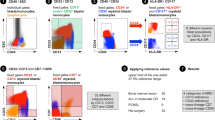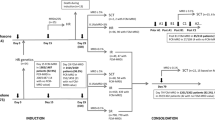Abstract
The level of minimal residual disease (MRD) early in treatment of acute lymphoblastic leukemia (ALL) strongly predicts the risk of marrow relapse. As a variety of methods of varying complexity have been separately used for detecting and quantifying MRD, we compared the prognostic utility of three methods – measurement of blast percentage on day 14 of treatment, detection of monoclonality on day 14 or day 35, and measurement of MRD by PCR-based limiting dilution analysis on day 14 or day 35. The study group comprised 38 children aged 1–15 with Philadelphia-negative B-lineage ALL who were uniformly treated and followed until relapse or for a minimum of 5 years. We also studied some of the technical factors which influence the ability to detect MRD. Measurement of blast percentage on day 14 by an expert morphologist, detection of monoclonality on day 35, and PCR-based measurement of MRD levels on days 14 and 35 all showed significant ability to divide patients into prognostic groups. Measurement of blast percentage on day 14 by routine morphology or detection of monoclonality on day 14 were not useful. The quality of DNA samples varied greatly, as determined by amplifiability in the PCR. However, virtually all amplifiable leukemic targets in a sample were detectable which suggests that the level of detection achieved by limiting dilution analysis is essentially determined by the amount of DNA which it is practicable to study. We conclude that quantification of MRD at the end of induction provides the full range of prognostic information for marrow relapse but is complex; detection of monoclonality on day 35 is simple and has good positive predictive value; and quantification of MRD on day 14 merits further study. PCR-based methods for measurement of MRD levels should incorporate a correction for variation in DNA amplifiability.
This is a preview of subscription content, access via your institution
Access options
Subscribe to this journal
Receive 12 print issues and online access
$259.00 per year
only $21.58 per issue
Buy this article
- Purchase on Springer Link
- Instant access to full article PDF
Prices may be subject to local taxes which are calculated during checkout



Similar content being viewed by others
References
Brisco MJ, Condon J, Hughes E, Neoh SH, Sykes PJ, Seshadri R, Toogood, I, Waters K, Tauro G, Ekert H, Morley AA . Outcome prediction in childhood acute lymphoblastic leukaemia by molecular quantification of residual disease at the end of induction Lancet 1994 343: 196–200
Steenbergen EJ, Verhagen OJ, Van Leeuwen EF, van den, Behrendt H, Slater RM, von dem Borne AE, van der Schoot CE . Prolonged persistence of PCR-detectable minimal residual disease after diagnosis or first relapse predicts poor outcome in childhood B-precursor acute lymphoblastic leukemia Leukemia 1995 9: 1726–1734
Jacquy C, Delepaut B, Van Daele S, Vaerman JL, Zenebergh A, Brichard B, Vermylen C, Cornu G, Martiat P . A prospective study of minimal residual disease in childhood B-lineage acute lymphoblastic leukaemia: MRD level at the end of induction is a strong predictive factor of relapse Br J Haematol 1997 98: 140–146
Coustan-Smith E, Behm FG, Sanchez J, Boyett JM, Hancock ML, Raimondi SC, Rubnitz JE, Rivera GK, Sandlunch JT, Pui CH, Campana D . Immunological detection of minimal residual disease in children with acute lymphoblastic leukaemia Lancet 1998 351: 550–554
Cave H, van der Werff ten Bosch J, Suciu S, Guidal-Giroux C, Waterkeyn C, Otten J, Bakkus M, Thielemans K, Grandchamp B, Vilmer E . Clinical significance of minimal residual disease in acute lymphoblastic leukemia. European Organisation for Research and Treatment of Cancer – Childhood Leukemia Cooperative Group New Engl J Med 1998 339: 591–598
van Dongen JJ, Seriu T, Panzer-Grumayer ER, Biondi A, Pongers-Willemse MJ, Corral L, Stolz F, Schrappe M, Masera G, Kamps WA, Gadner H, van Wering ER, Ludwig WD, Basso G, de Bruijn MA, Cazzaniga G, Hettinger K, van der Does-van den Berg A, Hop WC, Riehm H, Bartram CR . Prognostic value of minimal residual disease in acute lymphoblastic leukaemia in childhood Lancet 1998 352: 1731–1738
Gruhn B, Hongeng S, Yi H, Hancock ML, Rubnitz JE, Neal GA, Kitchingman GR . Minimal residual disease after intensive induction therapy in childhood acute lymphoblastic leukemia predicts outcome Leukemia 1998 12: 675–681
Goulden NJ, Knechtli CJ, Garland RJ, Langlands K, Hancock JP, Potter MN, Steward CG, Oakhill A . Minimal residual disease analysis for the prediction of relapse in children with standard-risk acute lymphoblastic leukaemia Br J Haematol 1998 100: 235–244
Foroni L, Harrison CJ, Hoffbrand AV, Potter MN . Investigation of minimal residual disease in childhood and adult acute lymphoblastic leukaemia by molecular analysis Br J Haematol 1999 105: 7–24
Sykes PJ, Snell LE, Brisco MJ, Neoh S-H, Hughes E, Dolman G, Peng L-M, Bennett A, Toogood I, Morley AA . The use of monoclonal gene rearrangement for detection of minimal residual disease in acute lymphoblastic leukemia in childhood Leukemia 1997 11: 153–158
Owen RG, Goulden NJ, Oakhill A, Shiach C, Evans PA, Potter MN, Morgan GJ . Comparison of fluorescent consensus IgH PCR and allele-specific oligonucleotide probing in the detection of minimal residual disease in childhood ALL Br J Haematol 1997 97: 457–459
Sykes PJ, Neoh SH, Brisco MJ, Hughes E, Condon J, Morley AA . Quantitation of targets for the polymerase chain reaction by use of limiting dilution Biotechniques 1992 13: 444–449
Nachman JB, Sather NH, Sensel MG, Trigg ME, Cherlow JM, Lukens JN, Wolff L, Uckun FM, Gaynon PS . Augmented post-induction therapy for children with high-risk acute lymphoblastic leukemia and a slow response to initial therapy New Engl J Med 1998 338: 1663–1671
Brisco MJ, Condon J, Hughes E, Neoh SH, Nicholson I, Sykes PJ, Tauro G, Ekert H, Waters K, Toogood I, Seshadri R, Morley AA, The Australian and New Zealand Children's Cancer Study Group . Prognostic significance of detection of monoclonality in remission marrow in acute lymphoblastic leukaemia in childhood Leukemia 1993 7: 1514–1520
Trainor KJ, Brisco MJ, Story CJ, Morley AA . Monoclonality in B-lymphoproliferative disorders detected at the DNA level Blood 1990 75: 2220–2222
Trainor KJ, Brisco MJ, Wan JH, Neoh S, Grist S, Morley AA . Gene rearrangement in B and T lymphoproliferative disease detected by the polymerase chain reaction Blood 1991 78: 192–196
Brisco MJ, Condon J, Sykes PJ, Neoh SH, Morley AA . Detection and quantitation of neoplastic cells in acute lymphoblastic leukaemia, by use of the polymerase chain reaction Br J Haematol 1991 79: 211–217
Gaynon PS, Desai AA, Bostrom BC, Hutchinson RJ, Lange BJ, Nachman JB, Reaman GH, Sather HN, Steinherz PG, Trigg ME, Tubergen DG, Uckun FM . Early response to therapy and outcome in childhood acute lymphoblastic leukemia: a review Cancer 1997 80: 1717–1726
Evans PA, Short MA, Owen RG, Jack AS, Forsyth PD, Shiach CR, Kinsey S, Morgan GJ . Residual disease detection using fluorescent polymerase chain reaction at 20 weeks of therapy predicts clinical outcome in childhood acute lymphoblastic leukemia J Clin Oncol 1998 16: 3616–3627
Panzer-Grumayer ER, Schneider M, Panzer S, Fasching K, Gadner H . Rapid molecular response during early induction chemotherapy predicts a good outcome in childhood acute lymphoblastic leukemia Blood 2000 95: 790–794
de Haas V, Breunis WB, Verhagen OJ, van den Berg H, van der Schoot E . Accurate quantification of minimal residual disease at day 15, by real-time quantitative polymerase chain reaction identifies also patients with B-precursor acute lymphoblastic leukemia at high risk for relapse Blood 2000 96: 1619–1620
Brisco MJ, Sykes PJ, Dolman G, Hughes E, Neoh S-H, Peng L-M, Snell LE, Toogood IRG, Rice MS, Morley AA . Early resistance to therapy during induction in childhood acute lymphoblastic leukemia Cancer Res 2000 60: 5092–5096
Acknowledgements
This study was supported by the National Health and Medical Research Council, and Flinders 2000. MJB held a Peter Nelson Fellowship. We thank Marjorie Lee for assistance with clinical data, and Colin Story for assistance with samples and Adrian Esterman for assistance with statistics.
Author information
Authors and Affiliations
Rights and permissions
About this article
Cite this article
Brisco, M., Sykes, P., Hughes, E. et al. Comparison of methods for assessment of minimal residual disease in childhood B-lineage acute lymphoblastic leukemia. Leukemia 15, 385–390 (2001). https://doi.org/10.1038/sj.leu.2402044
Received:
Accepted:
Issue Date:
DOI: https://doi.org/10.1038/sj.leu.2402044
Keywords
This article is cited by
-
Assessing minimal residual disease (MRD) in leukemia: a changing definition and concept?
Bone Marrow Transplantation (2002)



